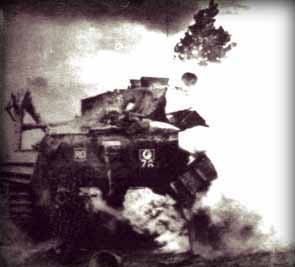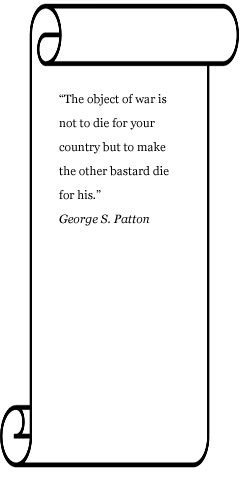|
British Tanks in Panzer Grenadier
By Mike Bennighof, Ph.D.
March 2012
Britain invented the tank, named it, and
first used it in battle. Like many first adopters,
the British Army fell behind the technological
race, and with some notable exceptions remained
behind the curve through most of World War
II. Sheer stolid bravery could only make up
for that in part. Here’s a look at some
of the British vehicles present in Beyond
Normandy.

Although his attempts as First Sea Lord to
name a battleship for his regicidal hero failed
repeatedly, Winston Churchill as prime minister
finally got Oliver Cromwell’s name on
a chunk of British iron in 1944. Part of a
long line of British cruiser tanks, these
continually improved from the introduction
of the A13 in 1939, a type widely used in
our games Afrika
Korps and Desert
Rats. Armor and armament
improved with the A27 Centaur, a type not
used widely in combat. With the introduction
of the Meteor engine the tank received a new
name, but it retained the A27 designation.
Some Centaurs were re-fitted with the Meteor
and also christened “Cromwell.”

Bad day for a Cromwell
crew,
near Hill 112 in Normandy, June 1944
Early models of the Cromwell carried a 6-pounder
gun, eventually receiving a 75mm gun in its
place. The pieces found in Beyond Normandy
are Cromwell VII vehicles, with a 75 mm and
welded hulls. The Cromwell was the most numerous
British tank at the time of the Normandy invasion,
but not as good a vehicle as the German PzKw
IVH or even the much-maligned American-made
Sherman.

The A22 Churchill went through a comparatively
long design and development phase, being ordered
in 1939 as a heavy “infantry tank.”
The early version had a 2-pounder gun in the
turret and a 3-inch howitzer in the hull,
a concept very similar to the American M3
Grant or French Char-B but with a much narrower
field of fire for the heavy gun. Initial tests
were highly unfavorable, and as Winston himself
said, “this tank carrying my name has
more drawbacks than me.” It had a reliable
engine, but the high tracks proved vulnerable
to enemy fire and when damaged blown tracks
would sometimes jam the turret.
The Churchill III and IV were sent to the
Mediterranean theater with a new turret carrying
a 6-pounder gun and only a machine gun in
the hull. During the invasion of Italy, ordnance
troops replaced the 6-pounder with 75mm guns
salvaged from wrecked Shermans, making a very
successful makeshift conversion. This became
official with the Mark VII, and many of the
earlier marks would be re-fitted to the same
standard. This did not carry the same 75mm
gun as the Sherman, but rather a 6-pounder
re-bored to accept the same ammunition.
Despite astonishingly slow speed, the Churchill’s
thick armor made it a favorite with the troops,
and it served throughout World War II and
in Korea as well. Just over 300 were sent
to the Soviet Union and the last Churchill
left the Irish Army’s service in 1969.

During the course of World War II, Britain
received thousands of American-made tanks
through the Lend-Lease program. Although the
Sherman’s 75mm gun was much better
than the British 6-pounder (57mm), it was
never truly adequate as a tank’s main
weapon. During the design of the M3 Grant,
bureaucrats of the U.S. Army’s artillery
branch insisted that the new tank’s
main armament meet artillery performance standards.
The 75mm M2 tank gun had to be able to fire
4,000 rounds before the tube’s replacement,
just like a field gun, despite the fact that
no tank could be expected to last in combat
long enough to fire a fraction of that volume.
Thanks to this turf battle, the M3 and the
following M4 Sherman went into action with
a low-velocity gun.
Dissatisfied with the weapon, but not under
the thumb of the American War Department,
the British modified a number of their Shermans
to a new standard. They replaced the 75mm
with their own high-velocity 17-pounder anti-tank
gun, a 76mm weapon but with a much longer
barrel and therefore muzzle velocity, and
firing a far larger round. To accomplish this,
they had to cut out the rear wall of the Sherman’s
turret and add an armored box, add a new hatch
for the loader and mount the cannon sideways.
To carry a reasonable number of the big 17-pounder
rounds, they also removed the bow machine
gun and gunner.
Re-christened “Firefly,” this
re-built vehicle proved far more effective
against German armor. Almost as fast as a
standard Sherman, it was not quite as good
as a German PzKwIVH but at least the gap had
been narrowed.


In 1940, Maj. Gen. Percy Hobart ran afoul
of higher authority and was forced into retirement.
Hobart joined his local Home Guard unit as
a corporal, but soon gained Churchill’s
favor and jumped from that post to command
the 7th Armoured Division in North Africa.
From there, he received the assignment in
1943 to create the 79th Armoured Division,
a unit dedicated to use of unusual armored
engineering vehicles known as “Funnies.”
In theory, the 79th would operate as a modern
siege train, using its odd assortment of tanks
to support attacks against German fortifications.
The 79th never operated together as a division,
instead lending its assets where needed. It
saw extensive action in the battles around
Hill 112 in Normandy, as depicted in our Beyond
Normandy game.
These specialized tanks included the Crocodile,
a Churchill tank that traded its 75mm gun
for a flamethrower and towed a trailer loaded
with 400 gallons of fuel behind it. Other
oddities included the AVRE (Armored Vehicle,
Royal Engineers), sporting a massive “Petard”
siege mortar in place of its gun, and the
“Crab,” a Sherman tank pushing
a huge drum with chains attached, to explode
mines.
The U.S. Army rejected this route, believing
the effort expended was not worth the expense.
However, the British Army seems to have been
very pleased with its return on investment
and greatly missed the “funny”
tanks during the Market Garden operation in
September 1944.
Put these tanks into action! Order Beyond Normandy TODAY! |


